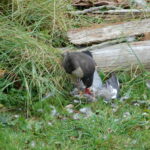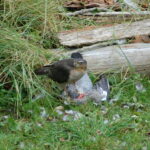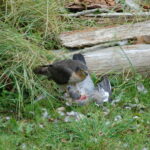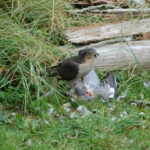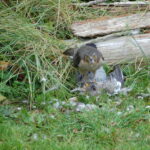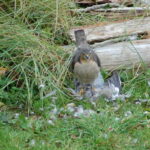Over the years I have many times come across circles of feathers on the ground, all that remained of an unfortunate bird, more often than not a pigeon. The culprit and the cause of what struggle had been played out had remained a mystery! Last October on Hooelake I finally spotted one of the culprits at work, a Sparrowhawk had caught a pigeon and was systematically devouring it’s prey! I watched and photographed it for 20 minutes or so before it eventually became suspicious of me and flew away carrying the remains of it’s catch.
“Sparrowhawk” derives its name from its habit of preying on sparrows.
Adult males have a brown/grey back and light brown/white underparts. Females are larger, with brown upper parts, a white stripe over the eye and dark barring underneath. Broad, rounded wings and long tail are adapted for flying between trunks and branches enabling them to weave in and out of trees at high speed.
Like all birds of prey, sparrowhawks don’t have teeth with which to chew their food. They instead tear small pieces to swallow using their razor sharp bill. To reach the edible parts, sparrowhawks must first pluck the feathers from their prey. This leaves large areas of the aforementioned scattered feathers, usually on lawns or other open spaces where they have brought down their prey.
“Sparrowhawks don’t hover like kestrels”
When & Where to see them
In the UK they can be seen all year round and are found everywhere, except for parts of the Scottish Highlands, the Western Isles and Shetland. It is found in woodlands, along hedgerows and in parks and gardens. In winter may be seen in more open areas such as salt marshes adjacent to woodland. Usually seen flying fast and low in pursuit of prey, or soaring high on rounded wings.
So if you do find a pile of feathers in your garden… investigate to see whether the bird they belonged to was eaten by a bird of prey like the sparrowhawk. Look at the very tip of the feathers quill and check to see if the end is still complete and rounded. If it is still in one piece, it is likely to have been plucked. If it is jagged or rough, it may have been chewed away from the body by a land predator like a cat.
More details on the Sparrowhawk can be found on the RSPB website
